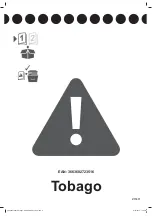
OTHER OTRO AUTRE
OTHER OTRO AUTRE
43
44
Copyright © 2016, Baby Trend Inc., All Rights Reserved. Todos los derechos reservados. Tous droits réservés.
Copyright © 2016, Baby Trend Inc., All Rights Reserved. Todos los derechos reservados. Tous droits réservés.
FCC Statement
This device complies with Part 15 of the FCC rules. Operation is subject to the fol-
lowing two conditions:
1 this device may not cause harmful interference, and
2 this device must accept any interference received, including interference that
may cause undesired operation.
WARNING:
Changes or modifications to this
unit not expressly approved by the party responsible
for compliance could void the user’s authority to
operate the equipment.
NOTE: This equipment has been tested and found to comply with the limits for a
Class B digital device, pursuant to Part 15 of the FCC Rules. These limits are de-
signed to provide reasonable protection against harmful interference in a residen-
tial installation. This equipment generates, uses and can radiate radio frequency
energy and, if not installed and used in accordance with the instructions, may
cause harmful interference to radio communications.
However, there is no guarantee that interference will not occur in a particular
installation. If this equipment does cause harmful interference to radio or television
reception, which can be determined by turning the equipment off and on, the user
is encouraged to try to correct the interference by one or more of the following
measures:
• Reorient or relocate the receiving antenna.
• Increase the separation between the equipment and receiver.
• Connect the equipment into an outlet on a circuit different from that to which the
receiver is connected.
• Consult the dealer or an experienced radio/TV technician for help.
Canada ICES-003 Statement
This Class B digital apparatus complies with Industry Canada Standard ICES-003.
Operation is subject to the following two conditions:
1 this device may not cause harmful interference, and
2 this device must accept any interference received, including interference that
may cause undesired operation.
Declaración de la FCC
Este dispositivo cumple con las normas de la Parte 15 de la Comisión Federal de
Comunicaciones (FCC). El funcionamiento está sujeto a las siguientes dos condi-
ciones:
1 este dispositivo no puede producir interferencias perjudiciales y
2 este dispositivo debe aceptar cualquier interferencia que reciba, incluyendo las
que puedan provocar un funcionamiento no deseado.
ADVERTENCIA:
Los cambios o modifi
caciones realizados a esta unidad, sin la aprobación
expresa de la parte responsable del cumplimiento,
podrían invalidar la autorización del usuario para
operar el equipo.
NOTA: este equipo ha sido probado y se ha encontrado que cumple con los
límites de dispositivos digitales de Clase B, de conformidad con las Normas de la
Parte 15 de la FCC. Estos límites han sido establecidos para brindar una protec-
ción razonable contra interferencias perjudiciales en una instalación residencial.
Este equipo genera, utiliza y puede irradiar frecuencias de radio y, de no insta-
larse y utilizarse de conformidad con las instrucciones, podría causar interferen-
cias perjudiciales en las comunicaciones de radio.
Sin embargo, no es posible garantizar que en una determinada instalación no se
producirán interferencias. Si este dispositivo provoca interferencias dañinas a la
recepción de radio o televisión, cuestión que puede determinarse encendiendo y
apagando el dispositivo, se insta al usuario a que intente corregir la interferencia
realizando uno o más de los procedimientos siguientes:
• Vuelva a orientar o colocar la antena de recepción.
• Aumente la separación entre el dispositivo y el receptor.
• Conecte el dispositivo a una toma de corriente diferente a la que se encuentra
conectado el receptor.
• Consulte al distribuidor o a un técnico de radio o TV experimentado para pedirle
ayuda.
Declaración ICES-003 de Canadá
Este dispositivos digitales de Clase B cumple con Norma ICES-003 de la Industria
de Canadá. El funcionamiento está sujeto a las siguientes dos condiciones:
1 este dispositivo no puede producir interferencias perjudiciales y
2 este dispositivo debe aceptar cualquier interferencia que reciba, incluyendo las
que puedan provocar un funcionamiento no deseado.


































